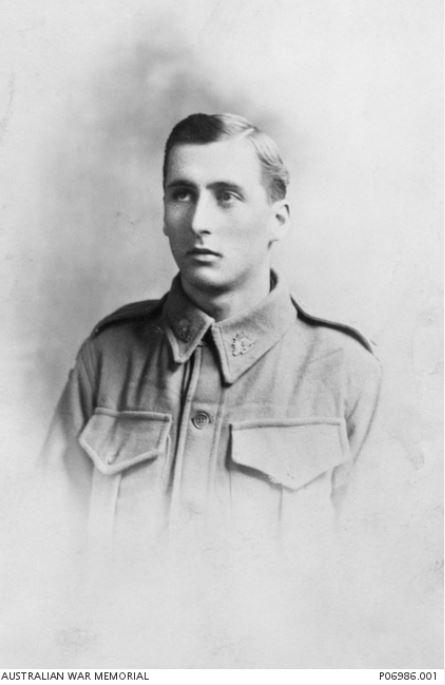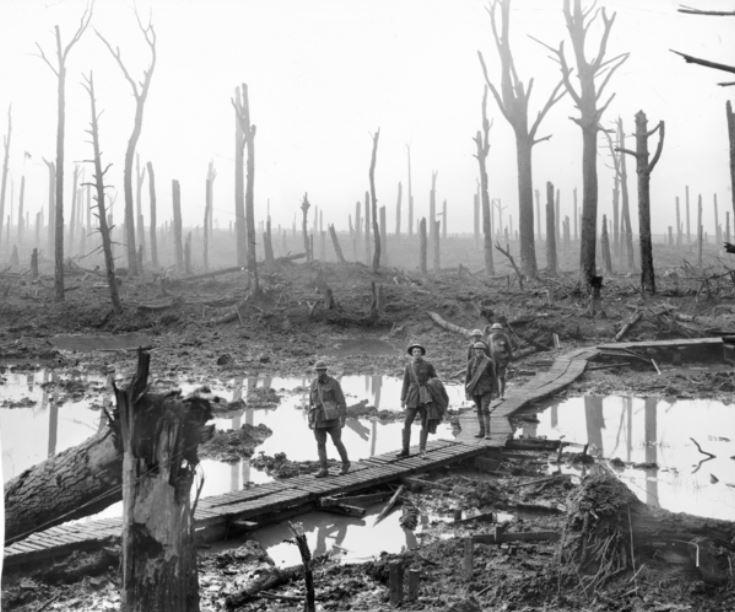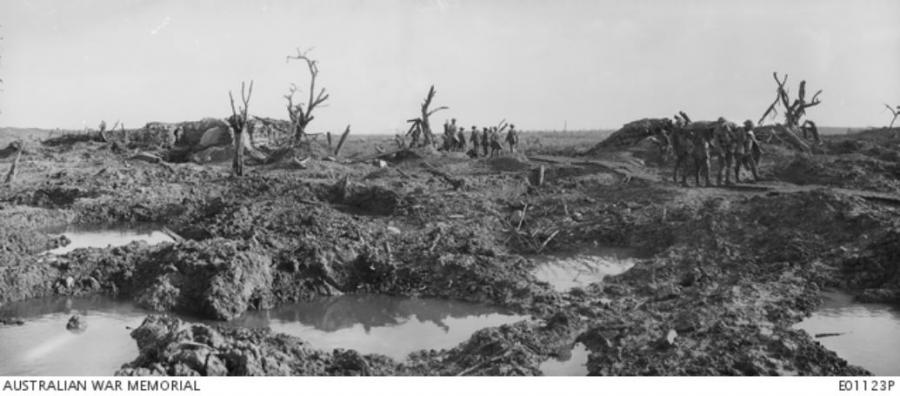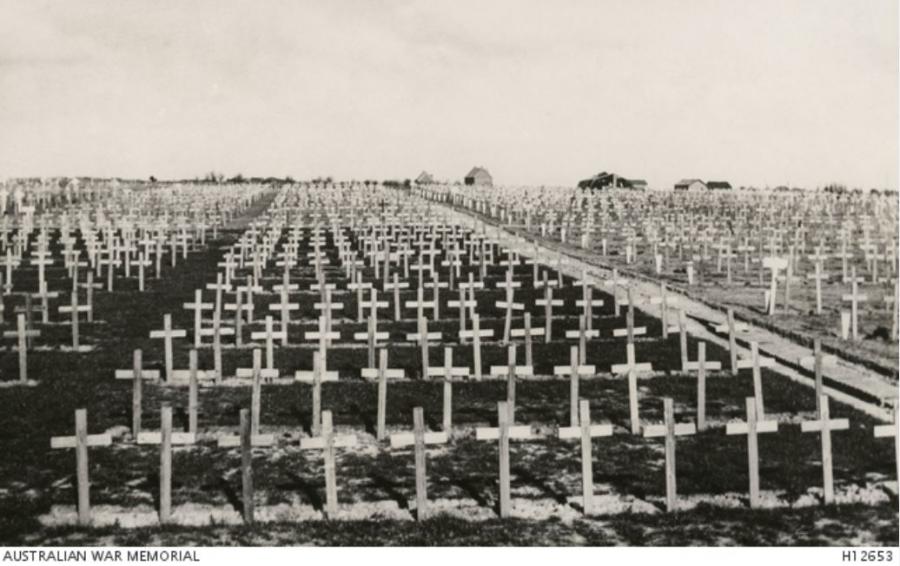'Theirs was a distant grief'

A former postman from Tasmania, David Absolom was known to his mates as “Bricky”.
It’s April 1918 and Emily Absolom is desperately seeking news of her son, David, who was reported missing amid the mud, death, and despair of the fighting at Passchendaele six months earlier.
“I have not received any information direct concerning my son,” Emily wrote from her home in Hobart. “But Private Joseph Stanley Case writing to his parents said, ‘I have just heard that Dave Absolom has been located in hospital, so am doing my best to find out whether the report is true.’ Other soldiers too have seemed to think he was in hospital.”’
Emily and her husband William clung to the hope that their son had survived, but in May 1918 their worst fears were confirmed. Twenty-three-year-old Corporal David Absolom, 40th Battalion, a former postman known to his mates as “Bricky” due to his stocky frame, had been killed instantly when a German high explosive shell landed amidst his platoon on 12 October 1917.
Corporal Absolom’s life was commemorated at a Last Post ceremony at the Australian War Memorial marking the 100th anniversary of the battle of Passchendaele.
“We thought that the fighting on the Somme was particularly bad. And then there was Passchendaele,” Aaron Pegram, a senior historian at the Australian War Memorial, said.
“The losses were staggering. In the eight weeks the Australians had participated in the Third Battle of Ypres, they lost 38,000 casualties, killed, missing and wounded. In October 1917, they incurred their greatest losses of the First World War. They lost 6800 dead. Those losses were unprecedented then and since.
“The great tragedy of all this is, in addition to the casualties, is that when the Germans launch their spring offensive in March 1918, all this territory that has been fought so hard for in late 1917 falls back into German hands.”
Pegram said people tended to remember the fighting at Passchendaele in terms of “endless mud and men falling off duck boards and drowning in the mud”.
“In fact most of the attacks that the Australians take part in are done in good, clear weather,” Pegram said. “It’s hot, it’s dry and, more importantly, it’s dusty.”
During the attacks - Menin Road on 20 September, Polygon Wood on 26 September and Broodseinde on 4October - large amounts of artillery and firepower destroyed the Belgian drainage system and the low-lying terrain was churned up by tens of thousands of troops.
“What happens after Broodseinde is the rains come - and it’s uncharacteristically heavy rain - and all that dry, dusty terrain then turns into a sea of mud,” Pegram said.

Frank Hurley's photograph of a field artillery brigade, passing along a duckboard track over mud and water among gaunt bare tree trunks in the devastated Chateau Wood, a portion of one of the battlegrounds in the Ypres salient.
AWM E01220
“That makes it quite difficult for the supporting artillery because the guns can’t be brought up through this liquid, glutinous quagmire. The infantry then pressed attacks towards Passchendaele village that aren’t properly supported by the artillery and the infantry flounder. Then they come across stiffening German resistance, and towards Passchendaele on 12 October 1917, they’re cut to pieces by German machine gun fire and devastating artillery fire.
“We need to take stock that despite the casualties, Menin Road, Polygon Wood and Broodseinde are remarkable successes. As part of the British offensive, the Australians carve out a large chunk of territory out of the German lines and the infantry take the objectives that they’ve set out to take. But it comes at a massive loss. The two attacks that occur after Broodseinde, Poelcappelle on the 9 October and Passchendaele on the 12October are indeed costly and unsuccessful.
“Those two actions characterise in some historians minds the futility of this offensive, which fails to achieve its objectives. The whole purpose of the offensive is to move beyond Passchendaele village, past the Gheluvelt Plateau and remove the Germans from the Belgian coast. But once that rain comes, it becomes very evident to British commanders that they can’t advance beyond Passchendaele and so the advance stalls.”
Sixty-one Victoria Crosses were awarded during the Third Battle of Ypres, nine of them to Australians.
“These mainly involve Australian troops attacking German pillboxes using bayonets and grenades to suppress machine-gun positions that are cutting their units to pieces,” Pegram said.
“But when it comes to the heroic actions, I think it’s the men who simply persisted, who may have scraped a small culvert out of a shell hole and withstood the German bombardment or the conditions while men were being killed all around them – I think that in itself is a different form of heroism.
“There’s a photograph of men of the Third Division taking shelter in a sunken road in a railway embankment just near what’s now Tyne Cot Cemetery and these men are literally doing just that. There’s dead Australians and dead Germans all around them, and they’re just in there in their little fox holes on the side of the railway embankment, utterly spent, utterly exhausted, sitting there in the mud and the rain.”

Dead and wounded Australians and Germans in the railway cutting on Broodseinde Ridge, in the Ypres sector, in Belgium, during the battle of Passchendaele, on October 12, 1917.
A few months later, Australian newspapers were flooded with in memoriam notices of men killed in the fighting.
“It would be fair to say there wasn’t an Australian community not affected by the fighting in Belgium during this time,” Pegram said.
“Owing to the sodden conditions and the weight of firepower in this offensive, men who were killed would be lost in the mud, or their makeshift battlefield graves obliterated.
“There is a staggering amount of men missing from this fighting, and back home that doesn’t give grieving families much solace. Perhaps they live in this forlorn hope that their boy has been taken prisoner by the Germans … and has lost his memory and has no idea who he was. And, of course, the reality is that he has been killed.”
Some travelled to Europe after the war in a desperate attempt to find their missing loved ones. The case of Captain Clarence Jeffries of the 37th Battalion, who was posthumously awarded a Victoria Cross for his actions at Passchendaele, is particularly poignant.
“Jeffries body was missing for a number of years and his father went to Belgium after the First World War to see the area where his son was killed and perhaps try and find his grave,” Pegram said.
When Jeffries’ body was later recovered and interred at Tyne Cot Cemetery, his father and mother returned to Belgium in the 1930s.
“Most Australians couldn’t afford to go to the battlefields, not even once, but this family in their depths of grief went twice,” Pegram said.
“For most Australians in the First World War who lost sons, brothers, husbands, theirs was a distant grief … Often times the only evidence, or the only part of a son, coming back is his personal effects –watches, religious books, wallets, or perhaps a letter or a pen – and they’re the things that families latch on to.”
For David Absolom’s mother Emily, that pain was all too raw as she waited in vain for her son’s personal effects to be be sent home.
“It is long over two years now and quite time that those things, which we value so much, were returned,” Emily wrote in February 1920. “Surely someone must know where the articles in question were dispatched to.”
In March 1921, she finally received word that her son’s personal effects – a purse, a fountain pen, a pair of scissors, photographs, a gold ring, silver match box, metal penholder, two bullets and a wallet – had been sent from England on board the SS Barunga, but that they would never make it home. The “vessel was lost at sea, with all cargo, as a result of enemy action”.

Stretcher bearers transporting wounded (right), while other troops (centre) move over a duckboard track running across a muddy Anzac Ridge, to the front line in the Ypres Sector.

A section of the Tyne Cot Cemetery in Belgium.